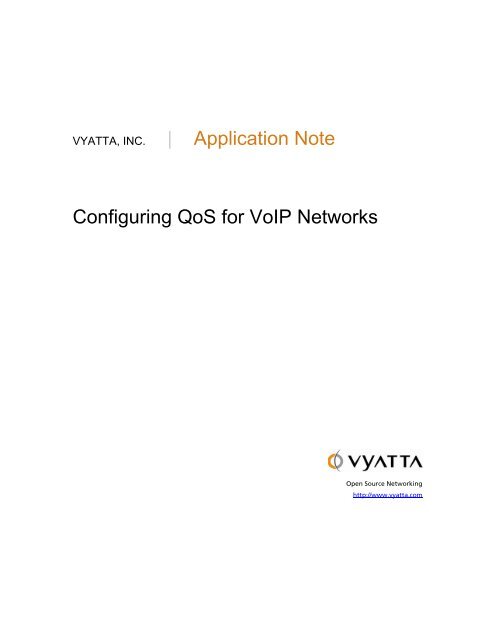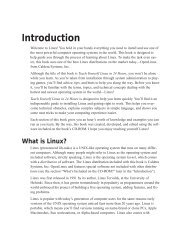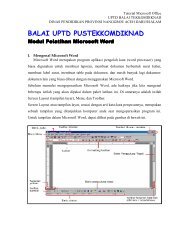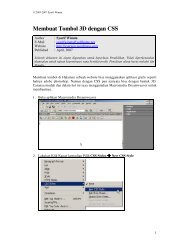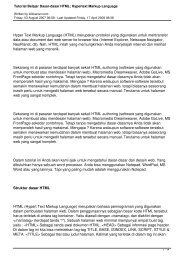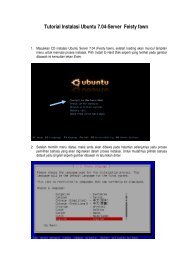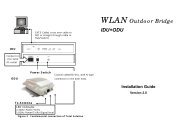| Application Note Configuring QoS for VoIP Networks - fileserver
| Application Note Configuring QoS for VoIP Networks - fileserver
| Application Note Configuring QoS for VoIP Networks - fileserver
You also want an ePaper? Increase the reach of your titles
YUMPU automatically turns print PDFs into web optimized ePapers that Google loves.
VYATTA, INC. | <strong>Application</strong> <strong>Note</strong><br />
<strong>Configuring</strong> <strong>QoS</strong> <strong>for</strong> <strong>VoIP</strong> <strong>Networks</strong><br />
Open Source Networking<br />
http://www.vyatta.com
VYATTA, INC. | <strong>Application</strong> <strong>Note</strong>: <strong>QoS</strong> Configuration<br />
Executive Summary<br />
Why <strong>QoS</strong>?<br />
This application note describes ways to configure Quality-of-Service (<strong>QoS</strong>)<br />
parameters on Vyatta <strong>for</strong> <strong>VoIP</strong> services in an IP Telephony network.<br />
Currently, Vyatta does not support <strong>QoS</strong> configuration in its CLI and Web GUI.<br />
This application note will describe how users can configure Vyatta outside<br />
the scope of the Vyatta management tools to provision <strong>QoS</strong>. In the near<br />
future, Vyatta will support integrated <strong>QoS</strong> configuration in its management<br />
tools.<br />
<strong>QoS</strong> is one of the most obfuscated technologies used in networking.<br />
Different users, vendors, and standards committees have distinct<br />
interpretations of what <strong>QoS</strong> is and how it should be implemented. Recently,<br />
Vyatta conducted a poll on its website and asked users to opine on what<br />
they would like <strong>QoS</strong> to be used <strong>for</strong> in their networks:<br />
What is the most important application <strong>for</strong> <strong>QoS</strong> in your network?<br />
• Voice over IP – 56%<br />
• Video – 9%<br />
• Real-time data – 7%<br />
• Limit apps on WAN – 14%<br />
• Limit apps on LAN – 8%<br />
• Other – 6%<br />
An overwhelming majority of respondents (56%) noted <strong>VoIP</strong> as the primary<br />
driver <strong>for</strong> network <strong>QoS</strong>. This corroborates anecdotal conversations Vyatta<br />
has had with its user-base.<br />
Using the Linux Kernel <strong>for</strong> <strong>VoIP</strong> Prioritization<br />
Vyatta is based on Linux which offers many ways to instrument <strong>QoS</strong> on the<br />
system. The Linux kernel’s inherent queuing and packet manipulation<br />
capabilities provide a simple way to achieve preferential treatment <strong>for</strong> <strong>VoIP</strong><br />
traffic. By identifying VOIP packets at an ingress interface and intelligently<br />
queuing them at the egress/outbound interface (typically <strong>for</strong> traffic exiting<br />
the LAN to WAN), we can detect and en<strong>for</strong>ce prioritization of <strong>VoIP</strong> traffic.<br />
Figure 1 shows a small-medium enterprise network with an Asterisk SIP<br />
server/media gateway and Vyatta edge router. In most SMB applications, a<br />
©2007 Vyatta, Inc. All rights reserved. /..2
VYATTA, INC. | <strong>Application</strong> <strong>Note</strong>: <strong>QoS</strong> Configuration<br />
simple packet marking and priority queuing mechanism will ensure that <strong>VoIP</strong><br />
quality is not compromised by other high-bandwidth data applications.<br />
Figure 1: An SMB <strong>VoIP</strong> Deployment Scenario<br />
T<br />
h<br />
e<br />
d<br />
e<br />
f<br />
a<br />
u<br />
l<br />
t<br />
VOIP PACKET MARKING<br />
The default queuing discipline (qdisc) on any Linux interface is PFIFO_FAST.<br />
While the name PFIFO_FAST suggests a simple First-In-First-Out queuing<br />
discipline, it provides more than that. PFIFO_FAST allows <strong>for</strong> 3 queues each<br />
of which represents a different priority level. A packet is placed into a queue<br />
depending upon the value of the TOS byte (or DSCP field) in the IP header of<br />
a packet.<br />
Let us set up packet marking such that <strong>VoIP</strong> packets get preferential<br />
treatment over other network traffic at an output interface. Moreover, this<br />
allows <strong>VoIP</strong> packets to carry the correct DSCP <strong>for</strong> upstream routers and<br />
switches.<br />
Today, Vyatta does not provide an integrated CLI to set DSCP bits. Users are<br />
advised to configure IPTables rules from the bash shell, outside the scope of<br />
the Vyatta CLI (login as “root” to access the bash shell).<br />
The following IPTables rules allow DSCP packet marking <strong>for</strong> <strong>VoIP</strong> packets:<br />
1) Mark SIP signaling packets<br />
iptables -t mangle -A POSTROUTING -p udp --dport 5060 -j<br />
DSCP --set-dscp 46<br />
2) Mark RTP media packets<br />
iptables -t mangle -A POSTROUTING -m helper --helper sip -j<br />
DSCP --set-dscp 46<br />
[DSCP 46 indicates Expedited Forwarding. Some implementations prefer the<br />
<strong>VoIP</strong> signaling packets to be set to DSCP 26 (Assured Forwarding Class 3<br />
Gold) or 34 (Assured Forwarding Class 4 Gold)].<br />
©2007 Vyatta, Inc. All rights reserved. /..3
VYATTA, INC. | <strong>Application</strong> <strong>Note</strong>: <strong>QoS</strong> Configuration<br />
<strong>Note</strong> that an Asterisk server or the <strong>VoIP</strong> media gateway system in your<br />
network can also be configured to mark the DSCP field on the <strong>VoIP</strong> signaling<br />
packets. The Asterisk server can also instruct the IP phones to mark the <strong>VoIP</strong><br />
media packets.<br />
TRAFFIC SHAPING AND BANDWIDTH MANAGEMENT<br />
Now that we have marking and simple priority queuing working, let us see<br />
how we can manage bandwidth requirements and queuing <strong>for</strong> multiple<br />
applications on a Vyatta router. The following scenario shows how users can<br />
use a class-based queuing discipline such as Hierarchical Token Bucket (HTB)<br />
to manage <strong>QoS</strong> <strong>for</strong> different applications. HTB ensures that the amount of<br />
bandwidth provided to each class is at least the minimum of the amount it<br />
requests and the amount assigned to it. When a class requests less than the<br />
amount assigned, the remaining (excess) bandwidth is distributed to other<br />
classes which request service.<br />
Take the example of a network manager who wants to have a simple policy<br />
of sharing an egress ethernet WAN link eth1, capable of providing 1.5 Mbps<br />
of upstream bandwidth, between data and <strong>VoIP</strong> in a branch network. The<br />
manager wants to allocate 1/3 rd of the upstream bandwidth to <strong>VoIP</strong> and the<br />
remaining bandwidth to data. The manager also wants to allocate 3/4 th of<br />
the data bandwidth <strong>for</strong> traffic bound <strong>for</strong> the corporate headquarters. <strong>Note</strong><br />
that any unused bandwidth can be used by any class which needs it (in<br />
proportion of its allocated share).<br />
Figure 2: SMB Traffic classification scenario<br />
IP Phone<br />
Asterisk Server<br />
<strong>VoIP</strong> – 500 Kbps<br />
Internet<br />
Vyatta Router/Firewall<br />
HQ<br />
Client PC<br />
Data-Internet 250 Kbps<br />
Data-HQ 750 Kbps<br />
IP Telephone Provider<br />
SIP.VOIPCOMPANY.COM<br />
©2007 Vyatta, Inc. All rights reserved. /..4
VYATTA, INC. | <strong>Application</strong> <strong>Note</strong>: <strong>QoS</strong> Configuration<br />
The above classification leads to three traffic classes as shown in Figure 2 in<br />
the branch network – <strong>VoIP</strong> (500 Kbps), Data-HQ (750 Kbps) and Data-<br />
Internet (250 Kbps). The following steps using the Linux traffic control tool<br />
“tc” will help us achieve the network manager’s <strong>QoS</strong> goals <strong>for</strong> the different<br />
kinds of traffic.<br />
1) Create an HTB qdisc <strong>for</strong> ethernet interface eth1 and give it an identifier<br />
referred to as handle 1:<br />
tc qdisc add dev eth1 root handle 1: htb default 30<br />
The default 30 in the above configuration means that any traffic that is<br />
not otherwise classified will be assigned to class 1:30.<br />
2) Configure the classes <strong>for</strong> the different traffic streams <strong>for</strong> <strong>VoIP</strong>, Data-HQ<br />
and Data-Internet. Creating a root class (1:1 as shown below) under the htb<br />
qdisc allows the child classes to share unutilized bandwidth in the pipe.<br />
tc class add dev eth1 parent 1: classid 1:1 htb rate 1.5mbit<br />
ceil 1.5mbit<br />
tc class add dev eth1 parent 1:1 classid 1:10 htb rate<br />
500kbit ceil 1.5mbit<br />
tc class add dev eth1 parent 1:1 classid 1:20 htb rate<br />
750kbit ceil 1.5mbit<br />
tc class add dev eth1 parent 1:1 classid 1:30 htb rate<br />
250kbit ceil 1.5mbit<br />
3) Create filters using IP DSCP and destination IP address to match traffic<br />
corresponding to the <strong>VoIP</strong> and Data-HQ traffic respectively. Any packet not<br />
classified by the two rules will be put in class 1:30 or Data-Internet.<br />
tc filter add dev eth1 protocol ip parent 1:0 prio 1 u32<br />
match ip dscp 46 0xff flowid 1:10<br />
tc filter add dev eth1 protocol ip parent 1:0 prio 1 u32<br />
match ip dst 5.6.7.8 flowid 1:20<br />
4) One can optionally attach queuing disciplines with configurable queue<br />
lengths to the above traffic classes to control latency as shown below.<br />
tc qdisc add dev eth1 parent 1:10 handle 20: pfifo limit 5<br />
The above examples show how the Linux traffic control and IPTables<br />
instruments can be used to deliver prioritized <strong>VoIP</strong> treatment in an SMB or<br />
enterprise branch environment. For understanding HTB configuration<br />
parameters, users are encouraged to visit the HTB user guide at<br />
http://luxik.cdi.cz/~devik/qos/htb/manual/userg.htm#intro<br />
For users looking <strong>for</strong> more advanced <strong>QoS</strong> techniques, Class Based Queuing<br />
(CBQ) provides a method to queue as well as shape packets. However, as<br />
often is the case with advanced and complex technologies, slight mis-<br />
©2007 Vyatta, Inc. All rights reserved. /..5
VYATTA, INC. | <strong>Application</strong> <strong>Note</strong>: <strong>QoS</strong> Configuration<br />
Conclusion<br />
References<br />
configurations may cause CBQ to work inefficiently and inaccurately at<br />
times. This application note will not go into the details of CBQ configuration.<br />
Interested users are encouraged to visit the Linux Advanced Routing and<br />
Traffic Control (LARTC) website at<br />
http://lartc.org/howto/lartc.qdisc.classful.html <strong>for</strong> more in<strong>for</strong>mation.<br />
<strong>QoS</strong> provides a strong example where the vast Linux feature set can be<br />
harnessed to provide functionality required by customers on Vyatta’s<br />
increasingly integrated solution. Today, users can make use of the native<br />
Linux kernel <strong>QoS</strong> mechanisms, through the standard IPtables and tc tools, to<br />
configure the appropriate network behavior to protect <strong>VoIP</strong> and other<br />
traffic from congestion. Over the next few releases, Vyatta will integrate the<br />
traffic control instruments described in this paper into its configuration and<br />
management tools. This will provide users with a way to easily administer<br />
and provision <strong>VoIP</strong> in small-medium business or enterprise branch<br />
environments.<br />
1) Detailed Linux <strong>QoS</strong> treatise at LARTC: http://www.lartc.org/<br />
2) HTB manual and user guide:<br />
http://luxik.cdi.cz/~devik/qos/htb/manual/userg.htm#intro<br />
3) CBQ examples in Asterisk environments:<br />
http://www.<strong>VoIP</strong>-info.org/wiki/view/Asterisk+<strong>QoS</strong><br />
4) Diffserv Architecture RFC 2474 & RFC 2475 (http://www.ietf.org)<br />
FEEDBACK<br />
Have comments on this paper? Send them to feedback@vyatta.com<br />
©2007 Vyatta, Inc. All rights reserved. /..6


